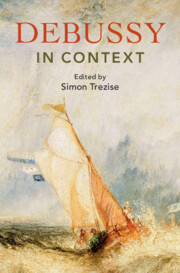Book contents
- Debussy in Context
- Composers in Context
- Debussy in Context
- Copyright page
- Dedication
- Contents
- Illustrations
- Contributors
- Preface
- Notes on the Text
- Abbreviations
- Part I Paris: City, Politics, and Society
- Part II The Arts
- Part III People and Milieu
- Part IV Musical Life: Infrastructure and Earning a Living
- Part V The Music of Debussy’s Time
- Part VI Performers, Reception, and Posterity
- Chapter 29 Performers and Performance
- Chapter 30 Early Music
- Chapter 31 Performance Today: Hearing Debussy Anew on Period Instruments
- Chapter 32 Debussy Today
- Recommendations for Further Reading and Research
- Index
Chapter 30 - Early Music
from Part VI - Performers, Reception, and Posterity
Published online by Cambridge University Press: 23 May 2024
- Debussy in Context
- Composers in Context
- Debussy in Context
- Copyright page
- Dedication
- Contents
- Illustrations
- Contributors
- Preface
- Notes on the Text
- Abbreviations
- Part I Paris: City, Politics, and Society
- Part II The Arts
- Part III People and Milieu
- Part IV Musical Life: Infrastructure and Earning a Living
- Part V The Music of Debussy’s Time
- Part VI Performers, Reception, and Posterity
- Chapter 29 Performers and Performance
- Chapter 30 Early Music
- Chapter 31 Performance Today: Hearing Debussy Anew on Period Instruments
- Chapter 32 Debussy Today
- Recommendations for Further Reading and Research
- Index
Summary
During the late nineteenth and early twentieth centuries in France a multiplatformed staging ground took shape for a wide variety of undertakings in music composed prior to 1750. Churches, schools, universities, private salons, select societies, major concert halls, and even opera houses became sites for performances of music dating from the Middle Ages to the Baroque. Sometimes, the repertoire of centuries past served as a point of focus for discussions about religion; at other times, it provided a vehicle for unabashedly secular, virtuosic performances. Choral performances in particular could as easily allow talented socialites to exert cultural influence as facilitate bonding among male workers. Through it all, the revival of early music provided the nation with a sense of artistic ancestry that could be summoned to shape notions of a collective musical identity, or even difference. This chapter shows how Debussy intersected with these powerful currents in his music, including his relationship to the music of the Ancien Régime in the form of Rameau.
- Type
- Chapter
- Information
- Debussy in Context , pp. 281 - 290Publisher: Cambridge University PressPrint publication year: 2024

